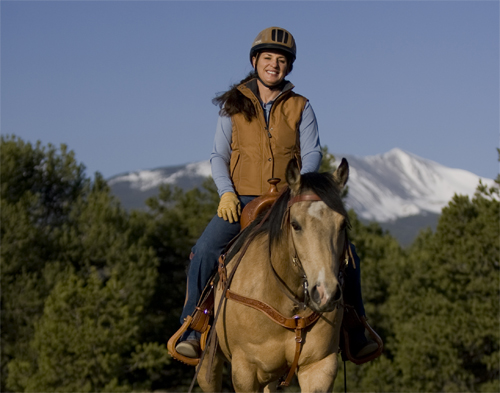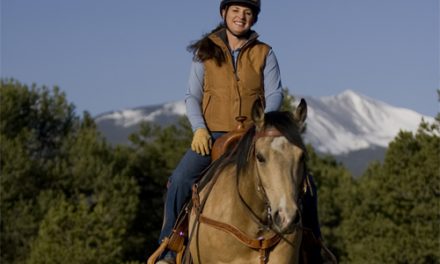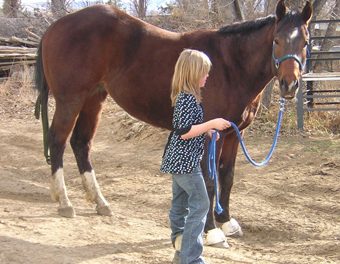Notes From Julie

I grew up in Florida, where the main riding season is the winter. Our main chore to get ready for winter was body clipping the horses, to get rid of the winter coat they were not going to need. For the last 30+ years, I’ve lived in the mountains of Colorado, at an altitude of 8000 feet, where the winters are long and cold and preparing your horse and barn for the winter comes with some important concerns.
Depending on your climate, your barn and the facilities you have to work with, preparing for winter may mean a lot of work! We all have unique challenges in the winter that may vary from dealing with ten-foot snow drifts to dealing with eight inches of mud, but my first concern is always making sure my horses will be comfortable for the long winter ahead.
While winters here in the mountains are long and hard, with temperatures well below zero at times, it’s not that bad everywhere (and much worse some places). Whether your winters are mild or wild, you might find a few things to think about, as you prepare your horses for winter. My biggest concerns to prepare my horses for winter are transitioning the horses’ diets, winterizing their water sources, preparing their hooves, checking their parasite status, and organizing blankets.
The Grass is not Greener
My horses have free-choice access to hay and/or grass 24/7, but late in the summer as the grass starts losing its nutritional value, the horses start transitioning themselves to more of a hay diet. Since Fall comes early here, by mid-August, the horses start eating more hay and less green grass, all on their own. Since we offer both hay and green grass to the horses in the late summer, they will slowly transition themselves to an all-hay diet by the time the grass goes dormant.
Unlike the Spring, when we must be very careful transitioning the horses from an all-hay diet to an all-grass diet, in the fall the transition is easier. However it’s done at your place, it is important to make any change in diet gradually. Whenever we are changing a horse’s diet, we always put them on a pre/pro-biotic like Proviable throughout the transition period, to aid in digestion.
After over thirty years in the horse business, I’ve learned many hard lessons about buying hay. First, I always buy a year’s worth of hay in the fall. I will not take the chance of running out of hay in the spring when hay can be very scarce and expensive. I will not buy hay right out of the field. It’s not fully cured until it’s been in the stack for 30 days. Some hay can look absolutely beautiful for a few weeks after it’s baled but can turn bad in the stack thirty days later if it was baled with too much moisture.
For my horses, I buy straight grass hay, top-quality, no rain on it. We buy large bales, which are a challenge to move around, but the cost savings is significant. I’ll also buy a few tons of small bales so that when I travel with my horses, I have some hay to take on the road.
I’ve found that hay prices are lowest and most stable in the fall and I can usually find the best quality then too. An uncomplicated way to budget your hay is to plan on using 1/3 a ton per horse per month; so, three horses are going to consume about one ton a month. I like to buy 10 months’ worth of hay in September; that should take me through July, when the new crop comes in and when the grass is in full swing. If you may have spoilage, add 10%. If your herd numbers fluctuate, overbuy your hay. If it’s well stored, hay will retain its nutritional value for up to a couple years after it’s baled. So I’d rather have extra hay in the Spring (when hay is the most expensive)—I’ll be sure to use it up first before I start feeding the next year’s crop.
Winterizing Water Sources
Frozen water sources can be one of the biggest challenges in winter horse keeping. Just like us, it’s easy for a horse to get dehydrated because he is not drinking enough water when he is cold. Dehydration is a huge factor in colic, so I do everything I can to make sure my horses are adequately hydrated all winter long, including heating their water and adding an equine drink mix like Rein Water, which encourages drinking.
As the nighttime temps drop below freezing, we hang heated water buckets in the stalls. I prefer not to have automatic waterers in their stalls, so I know exactly how much water each horse consumed overnight. For the horses that stay outside, we have heated water sources too, but there’s no way to monitor individual consumption. Since the heated water sources are covered, it’s important that someone checks it twice a day to make sure it is not frozen or malfunctioning another way (like having an electric current running through the water).
If you are using stock tanks and tank heaters, make sure the heaters and wires are all functional and protected so that the horses will not break anything. Horses can be a real nuisance when it comes to fiddling with wiring and contraptions, especially on a water tank. They tend to hang out at the water source and can easily get bored or frustrated and start playing with the heater. If your winters are mellow, with little freezing at night. Then maybe all you need to do is break a little ice in the morning. Just keep in mind that the colder the water, the less your horse will drink, so consider heating some water for your horse.
Finally, all the hoses, the wash rack and implements must be thoroughly drained and put away for the winter. If you must use hoses in the winter to fill water tanks, it’s a huge chore in cold climates. Hoses must be drained twice to make sure they are usable the next time. Without fail, someone will mess up and you’ll end up with frozen hoses sometime during the winter. If so, just coil the hose and dump the whole thing in your heated stock tank. In no time, it will be thawed and you can drain it (much faster than dragging it in your house).
To Shoe or Not to Shoe?
Right behind food and water, I have a huge concern about getting the horse’s feet ready for winter. This can be complicated because each horse has unique needs and will be used differently over the winter. Without question, it is better if horses can be kept unshod, especially in the winter. Their hooves are healthier when unshod and they are less likely to slip on the ice or develop snowballs on their feet.
In cold climates like ours, we must be very careful with hooves as we transition from fall to winter. Some of our horses are shod in the summer, because of the demands of hard riding on rocky terrain. If you wait until the last minute to pull their shoes for the winter, their feet are very tender when the ground freezes hard and the horses can get dangerously footsore, even slightly laminitic. I want to pull their shoes well before the hard freeze, so their feet have time to toughen up before the ground gets rock hard. This is always a difficult choice for some riders who really enjoy trail riding in the fall and want to leave shoes on as long as possible. I prefer to pull shoes early if I can and use hoof boots on the trails so that the horse’s feet toughen up before the ground is frozen hard.
My first choice is to leave all the horses barefoot over the winter and for as long as I can. Most of my horses will go at least five months without shoes. However, some of our horses have therapeutic or corrective shoeing and they will stay shod, with special shoes and pads, usually on the fronts only. Sometimes we have horses that are in performance training and will wear sliders on the hinds, so we’ll leave them bare in the front and shod on the hinds. If horses are shod during the winter, we use snow pads on them to prevent the hard ice-balls from forming on their feet.
Does Your Horse Need a Blanket?
The short answer is, probably not. Horses are unbelievably adaptable animals and are well-equipped to deal with almost any climate. Did you ever hear of the cartoon, “South Park?” It’s a real place, not too far from where I live, and there are few places in the lower 48 that have a harsher winter. 25-30 below zero for weeks on end, deep snow and howling winds. Yet all winter long, you can drive through that valley and see hundreds of horses, unblanketed, doing just fine. If they have food and water and a windbreak, they are happy. For the most part, horses do not need blankets, but there are some situations when it’s a good idea.
First, in extreme weather, we always cover our geriatric horses (or any horses that are unhealthy or skinny). Horses need to eat more in the winter because they expend a lot of energy to stay warm. When a horse is barely keeping his weight without the cold, he may need some blanketing help in the coldest weather.
Keep in mind that when you blanket a horse and compress his haircoat, he loses some insulation value. Once you start blanketing a horse, you may need to continue. If you are flexible enough to only put the rug on just during inclement weather and leave him uncovered in the better weather, his winter coat may stay fluffy. But if you leave that blanket on for days or weeks on end, his coat will compress so much that you’ll need to leave him blanketed. Often, it’s best to leave it to nature and let the horse’s winter coat do its job.
Some of my horses stay blanketed all winter long. But make no mistake about it, this is entirely for human convenience, not because the horses need it. We ride our horses year-round, but from November through April, we are generally riding inside. For ease of use and for aesthetic reasons, we like to keep the winter coats as short as we can, so we keep them blanketed, starting early in the fall. Riding inside, in a warm indoor arena, horses with a full winter coat will get soaking wet and it’s impossible to get them dry before nightfall. Sometimes we trace clip the hair coat to manage the sweating and keep our horses dry when we ride. Blanketing and keeping their hair coats short, helps us manage the winter riding (and keeps them looking good for photo shoots too!).
Most horses don’t need blanketing, no matter how cold it is. However, it’s nice to have the choice, so we keep a good heavy, waterproof rug for each horse (we actually have sheets, mid-weights and heavy weights for each horse). I’ve bought hundreds, maybe more than a thousand horse blankets in my lifetime and I’ve learned through experience that you get what you pay for. Spending a few hundred dollars on a top-quality blanket is money well spent. Keep in mind that your horse will do its best to destroy the blanket; you’ll go through 3-4 cheap blankets before you replace one high-quality rug. I also want a winter blanket that wicks moisture, has a turtleneck and utilizes high-tech materials. We can usually get 3-4 years or more of use out of one heavyweight rug.
Check for Parasites
I do not de-worm my horses unless they need it. We do fecal egg counts in the Spring and Fall. If the report comes back negative for worms, we do not give them a de-wormer. If a horse shows a positive result, we will de-worm that individual accordingly. The fecal egg count is easy and no more expensive than the cost of a de-wormer if you send it to a lab. I do not want to give my horses any chemicals or medications they do not need, so the fecal egg count is a wonderful way to go.
You can do the egg count yourself (find instructions online) or you can order a testing kit and send it off to a lab. There are many sources available now, so just google it and figure out the best option for you and your horses. If horses are kept in very sanitary conditions and de-wormed as needed, you’ll find you have far fewer parasites to deal with.
If I did not do fecal egg counts, I would de-worm all my horses with ivermectin after the first hard frost. By waiting for the hard frost, your hope is to take care of the last of the parasites before the winter kill. If I only de-wormed once a year, I’d do it in the fall after the first hard frost. But honestly, it’s been a few years since any of our horses have been de-wormed because the reports come back clean.
Around here, winters are long and hard, and horse keeping can be a real challenge! Being prepared around the barn and getting your horse ready ahead of time will help a lot. Every climate and every facility has its own set of challenges in winter and summer and as the years pass by, we learn how to manage it better. If you’re new to horses, it pays to ask more experienced horse owners in your area what they do to get ready for the seasons. It helps to get ideas from others but it’s up to you to make the decisions on what’s best for you and your horses.
Enjoy the ride!
—Julie Goodnight
Trainer and Clinician
###
—
For more thoughts from Julie, watch her Horse Master TV show each week on RFD-TV or catch the show online anytime at TV.JulieGoodnight.com and please subscribe to the free YouTube channel at http://YouTube.com/juliegoodnight and find her on Instagram at http://www.Instagram.com/juliegoodnight. Check out her full list of clinics and appearances at: JulieGoodnight.com/calendar
Julie Goodnight takes on topics you want to know more about in her online training library—part of her ever-expanding Horse Master Academy (http://signin.JulieGoodnight.com) now with a free access membership to help you search for many training articles, videos and MP3s!
About Julie Goodnight
Goodnight is the popular RFD-TV host of Horse Master airing Monday nights. Goodnight travels the USA sharing her no-nonsense horsemanship training with riders of all disciplines. Goodnight has ridden in many different saddles– she’s experienced in dressage and jumping, racing, reining, cow horse, colt-starting, and wilderness riding. Goodnight grew up on the hunter-jumper circuits in Florida, but is now at home in the West. She and her husband, Rich Moorhead, live in the mountains in Salida, Colorado. Both love versatility ranch horse competitions and riding cow-horses.Explore her online library and many training videos at http://TV.JulieGoodnight.com; be sure to sign up for the free monthly training news at http://JulieGoodnight.com and please subscribe to the free YouTube channel at http://YouTube.com/JulieGoodnight.




